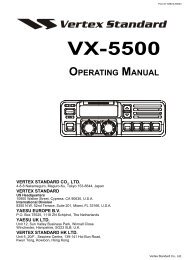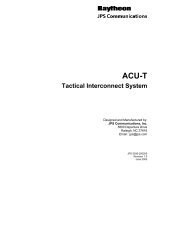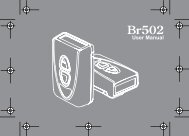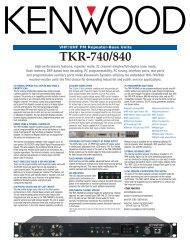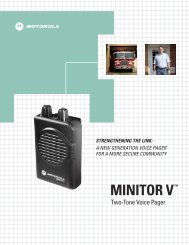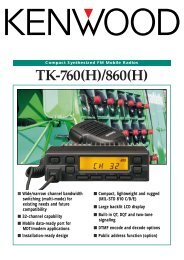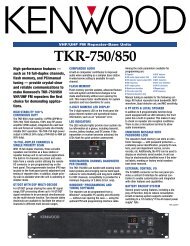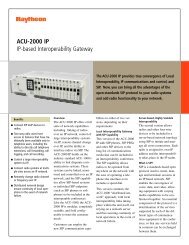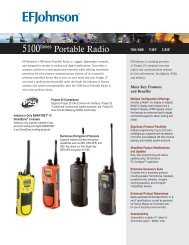DISTRIBUTED LOGIC TRUNKED RADIO SYSTEMS - Lauttamus ...
DISTRIBUTED LOGIC TRUNKED RADIO SYSTEMS - Lauttamus ...
DISTRIBUTED LOGIC TRUNKED RADIO SYSTEMS - Lauttamus ...
Create successful ePaper yourself
Turn your PDF publications into a flip-book with our unique Google optimized e-Paper software.
8Distributed Logic Trunking Technical Details:In distributed logic trunking systems, mobiles are ‘homed’ to a specific RF channel. Thishome channel is their default channel and will be used if it is not busy with other traffic. Ifthe mobile’s home channel is busy, the trunking system will trunk the mobiles to a freechannel within the system, continually reassigning the mobiles as necessary followingeach segment of the conversation exchange. It is important to note that any channelsassigned as home channels must be exclusive-use channels. Trunk-to channels (thenon-home channels in the trunking pool) may be either exclusive or shared channels.Controllers within a system are linked together via a high speed repeater data bus. Thisbus allows all system repeaters to know the current status of all other system repeaters(free or busy) and also identifies which mobile talkgroup is currently using which repeater.This data bus is a synchronized serial bus divided into 20 repeater time slots, one IDvalidation time slot and one spare (unused) time slot. Each repeater in the system (20maximum) continually updates the bus by placing the Home Channel ID of the mobilecurrently using the repeater in its own time slot on the bus. Each controller also readsthe data in all the other 19 repeater time slots to find out if one of its mobiles (a mobilehomed to this repeater) is using another repeater (has been trunked to another availablechannel).If it finds one of its own mobiles, this data is transmitted out as collection data so thatother mobiles listening with the same home channel and ID will be sent to the non-home(trunk-to) repeater to receive their call. Additionally, free repeater information iscontinually shared to all controllers so that all transmitted data contains free repeaterinformation. This updates idle mobiles so that they always know which repeater isavailable to make a call.Interaction between trunked mobiles and a distributed logic trunked repeater system isaccomplished through the use of continuous sub-audible data messages or data packets.Being sub-audible, they are transparent to the radio user and co-exist with voice traffic.Microprocessors in the mobiles interpret these data messages and use them to controlchannel switching, transmission and audio muting.Each distributed logic data packet is divided into synchronization bits, the area bit, go-toinstructions, home channel information, ID code information, free channel information anda calculated cyclic redundancy check number. Inbound data packets and outbound datapackets are the same length: 40 bits, each bit 3.3 mSec in length for a total of 132 mSecper data packet (or approximately 300 bps). In the following example, all bits (with theexception of the fixed sync bits) are illustrated as 1s:SYNC AREA GO-TO HOME ID CODE FREE CHAN CRC101011000 | 1 | 11111 | 11111 | 11111111 | 11111 | 1111111(fixed sync msg) 1 or 0 5 bits 5 bits 8 bits 5 bits 7 bits(Word length = 40 bits total.)KENWOOD U.S.A. CORPORATION – COMMUNICATIONS DIVISION678-474-4700 voice 1-800-TRUNKING 678-474-4730 fax



